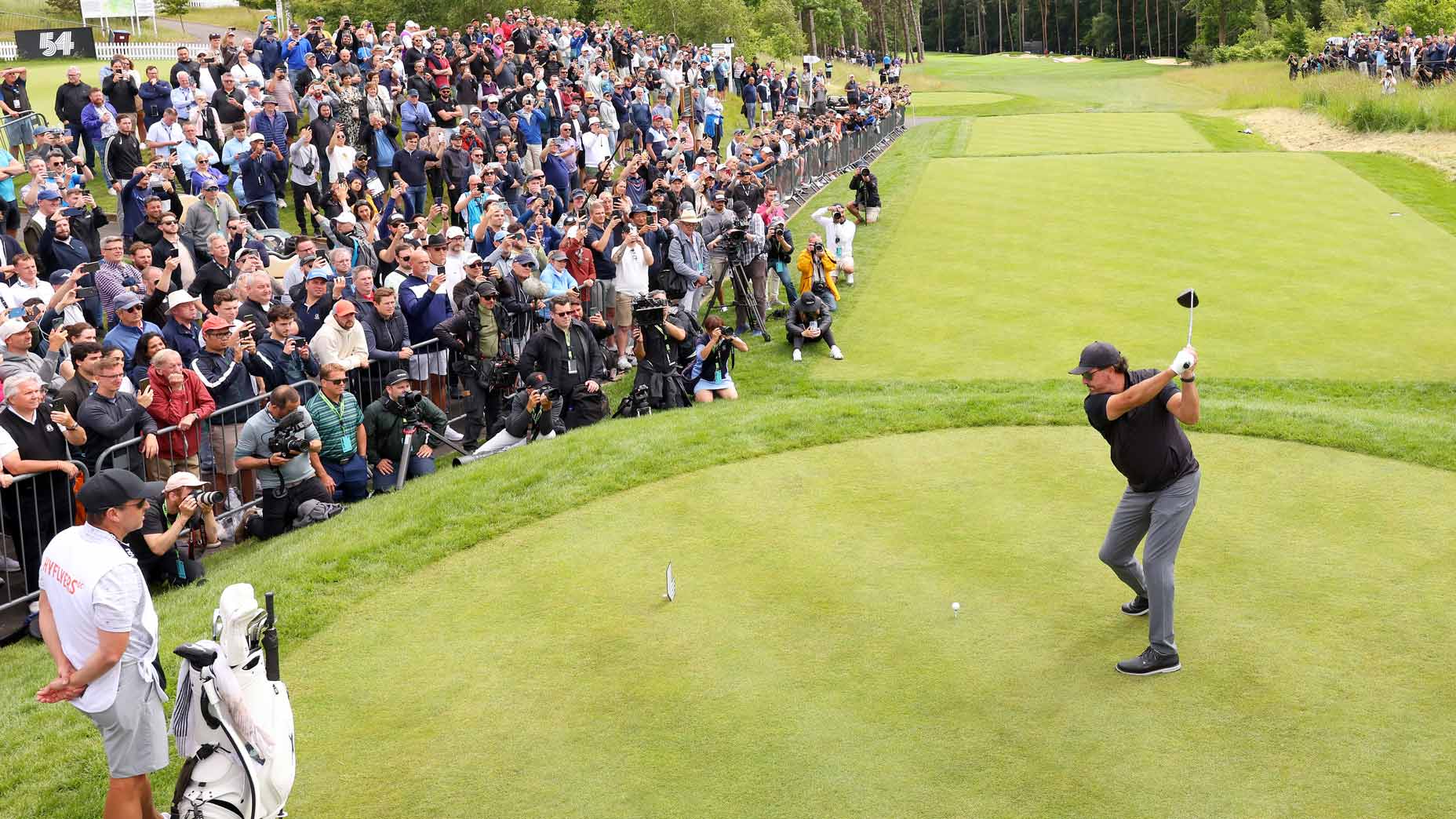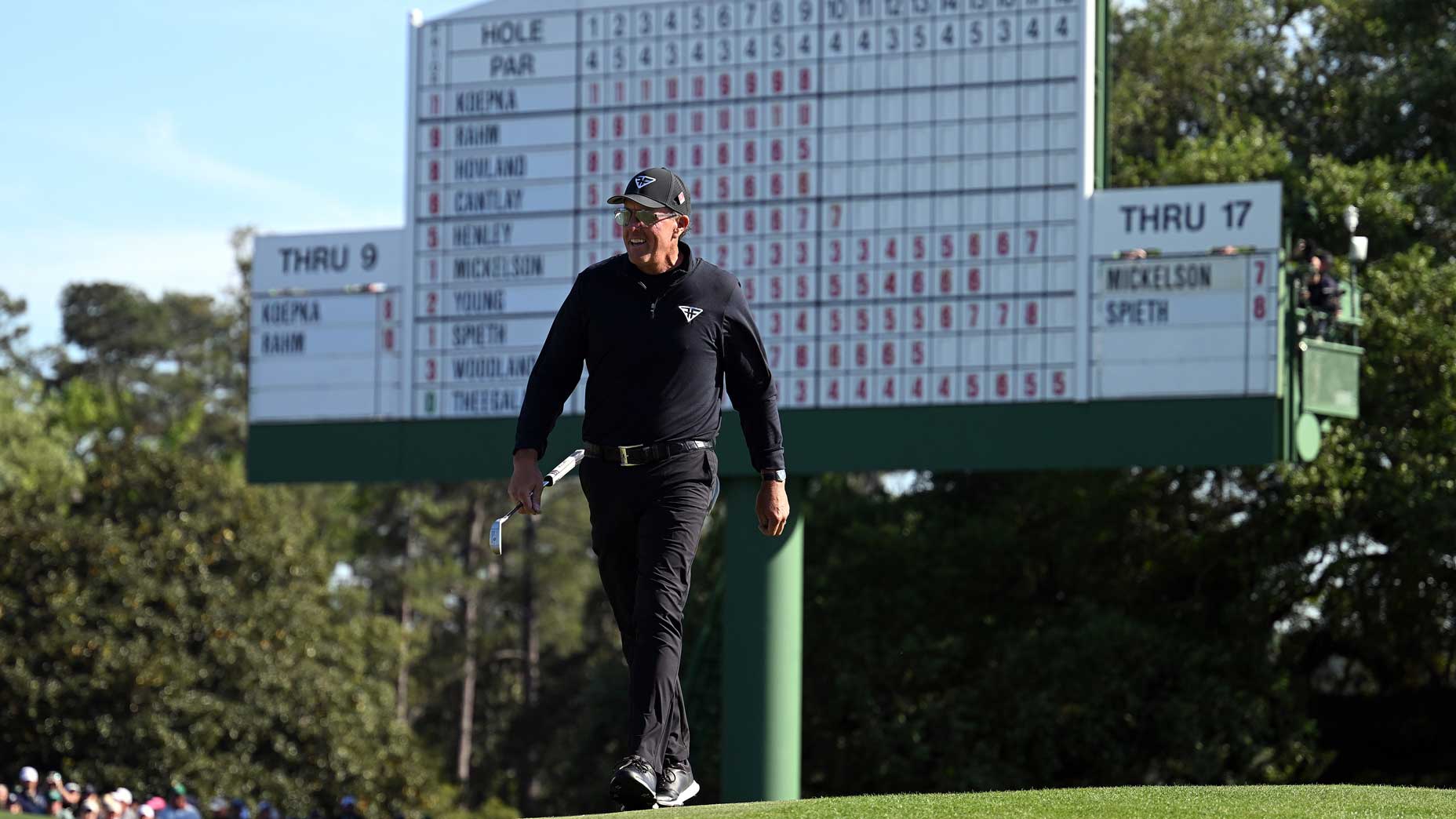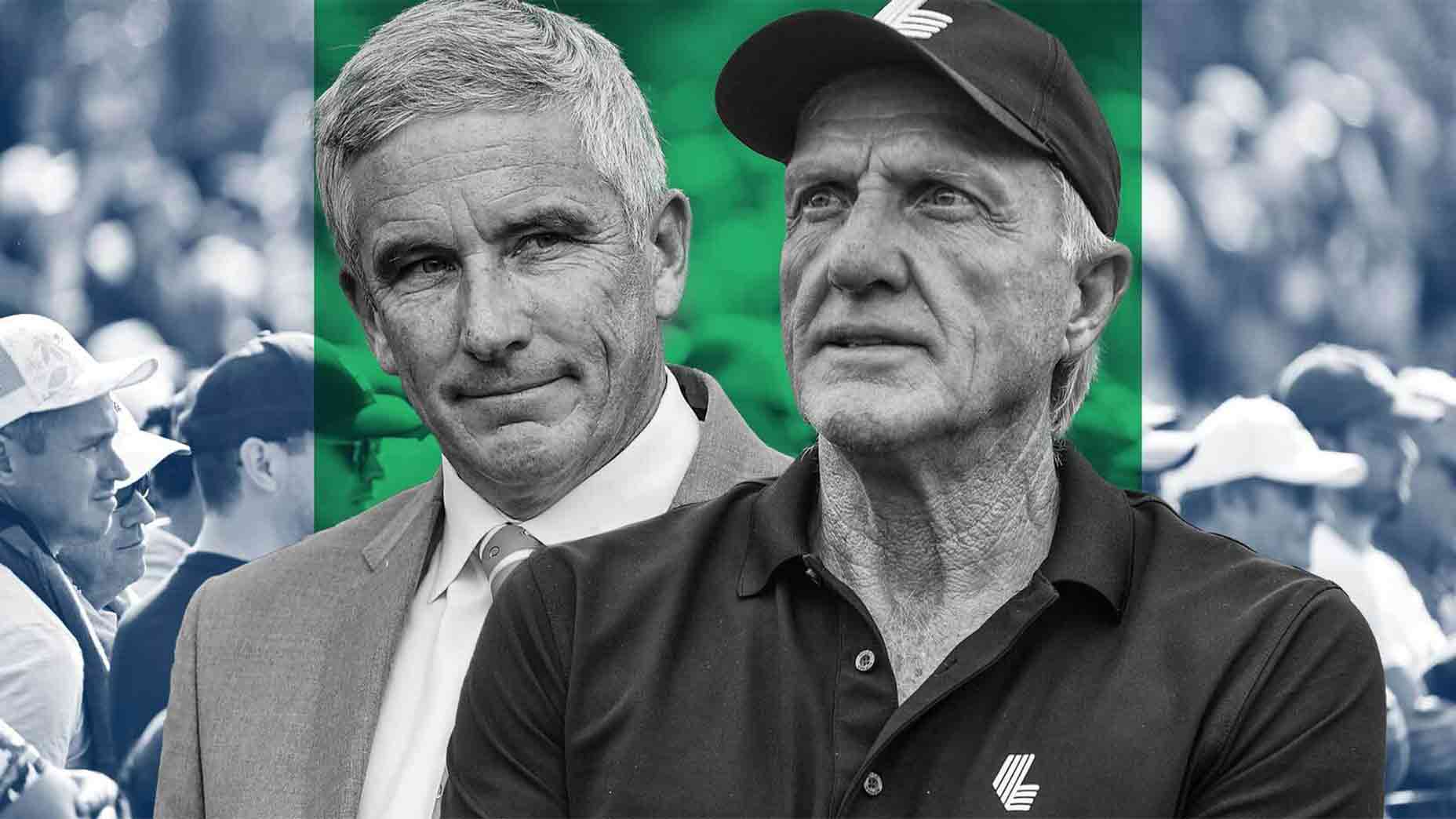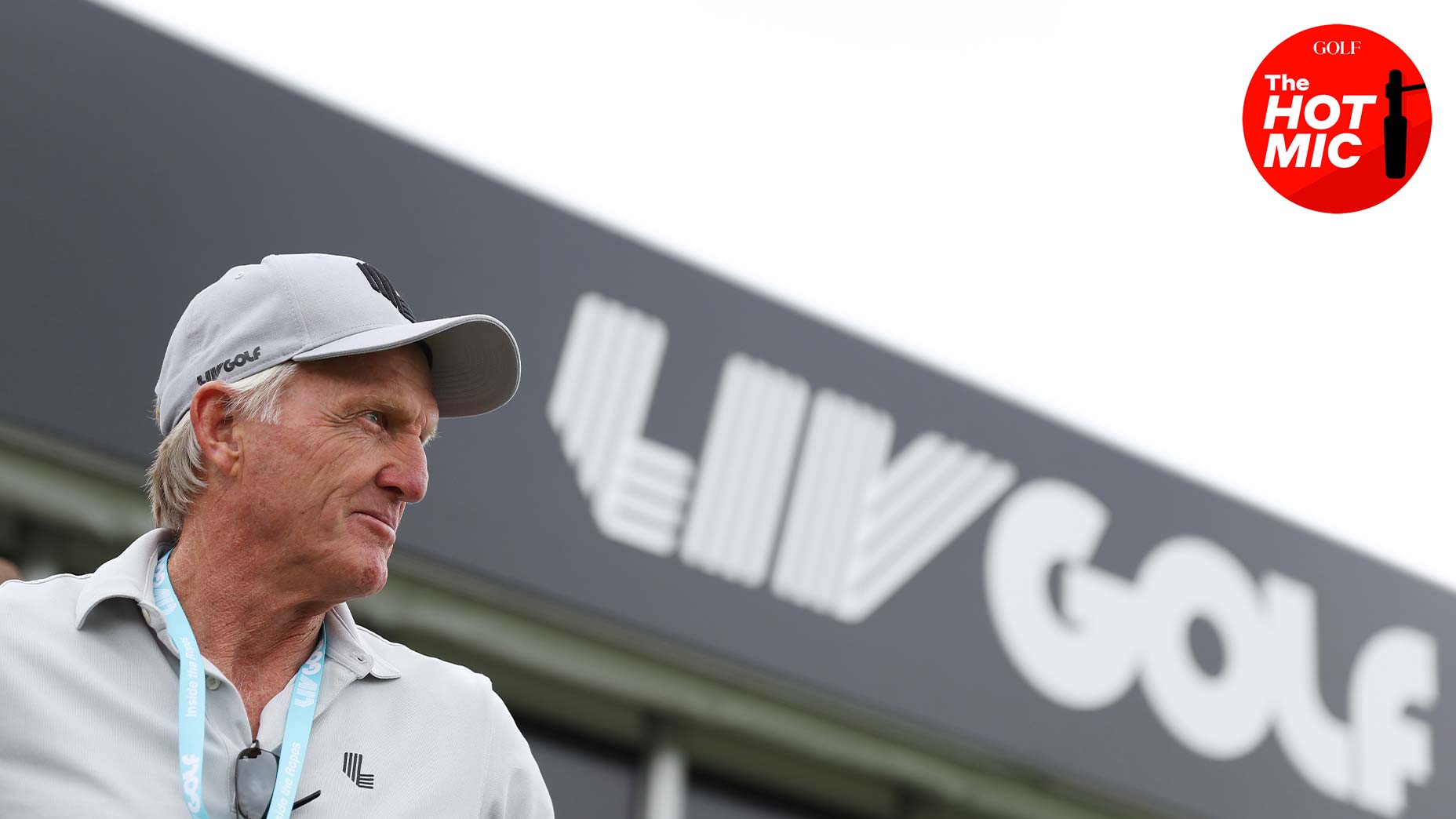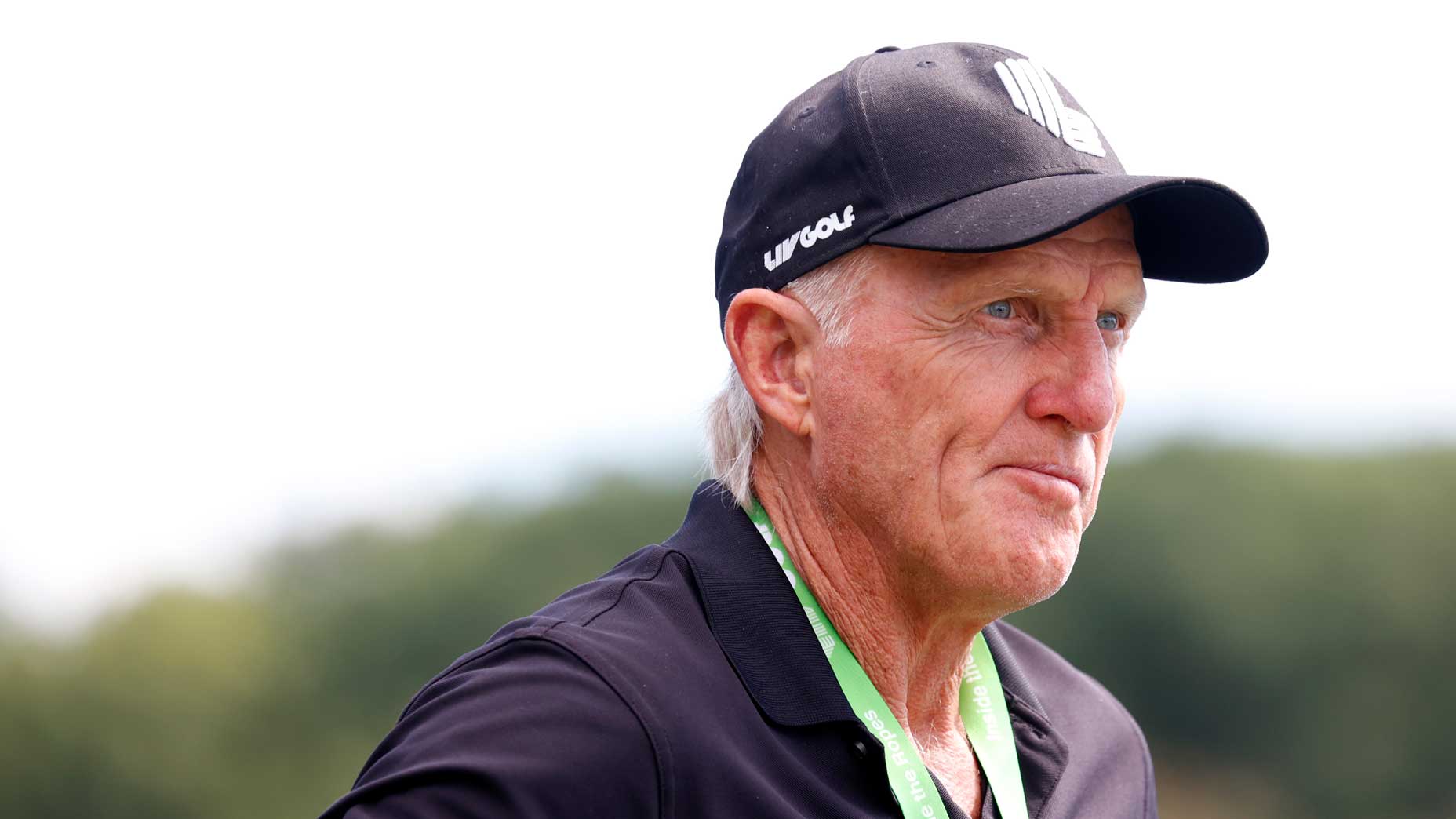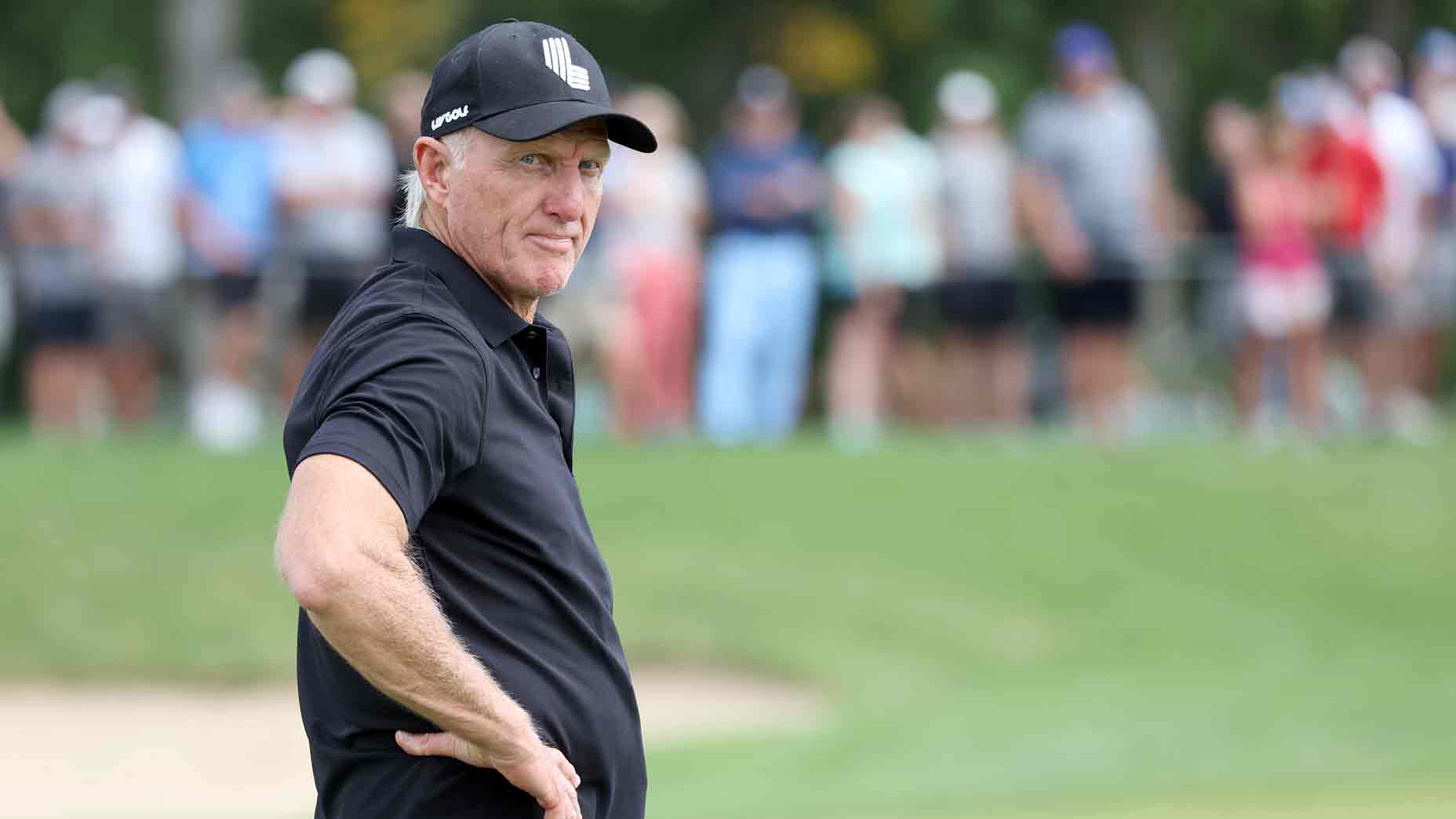ST. ALBANS, England — As Phil Mickelson warmed up for the first round of his strange, new LIV Golf life, his iPad was there on the turf, propped up by irony. The device leaned against a Presidents Cup Team USA drawstring bag, the kind of garb players receive only for being one of the best American players on the PGA Tour, and for starring in one of its flagship events.
Three hours later, right around the time he tapped in for par on his first hole at LIV Golf’s debut event, Mickelson was promptly suspended by the Tour, where he has played for the last three decades. Also suspended were the 47 other competitors in this inaugural rival golf event, spelled out in a memo Tour commissioner Jay Monahan sent to the Tour’s 200-plus members. Twenty minutes later, a response came from LIV: “Today’s announcement by the PGA Tour is vindictive and deepens the divide between the Tour and its members.”
Make no mistake, the LIV players had to know a response was coming — they signed up to be soldiers in this bewildering golf war — but couldn’t have known exactly when it would land. The timing of the suspensions only made it more surreal: they were handed down as the pros collectively played the second holes of their new golfing life, spread across the property at Centurion Club, thousands of fans looking on.
What eventually was a dark afternoon in the world of pro golf didn’t necessarily begin that way. About two dozen fans waited at the gates Thursday morning, anxious to see the fanciful event they’ve only been able to hear about. Hundreds of VIPs were already walking around the course — most everyone wearing expressions of curiosity. This is really it, huh?
The majority were drawn initially to the fan village, where a DJ mixed house music and temp workers lured spectators into various activities. “Welcome to the future of golf,” one said, just outside the pop-up arcade. Inside stood a digital board with scattering lights aglow: a hand-eye reaction machine. “This is what pro athletes use,” was the sales pitch. Two feet away, a pair of spectators leaned back on floor recliner chairs — the ones shaped like a banana — playing a LIV Golf-customized mini golf video game.
Nothing about this was normal for a pro golf tournament. But most things surrounding it were. Around 11:30 a.m., players began to take their typical formations on the range. Mickelson was among the first, soon joined by Ian Poulter and Kevin Na. The team aspect of the event — which isn’t as organic as it’s being advertised — could be seen in the driving range placards and the bibs worn by caddies, but not on the players. Mickelson wore all black for the second straight day, adding a new logo Thursday: Augusta National’s, on his vest.

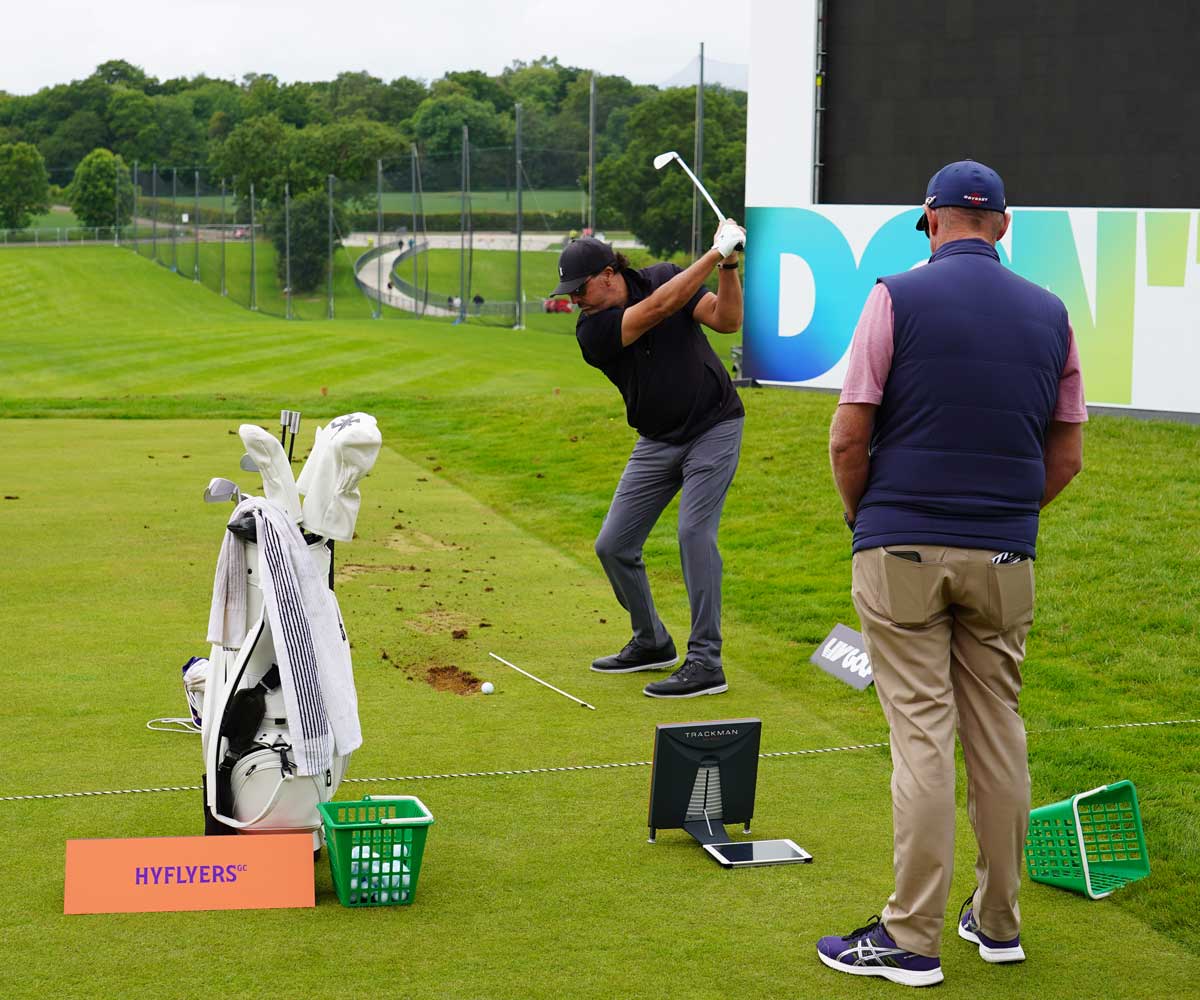
It didn’t take long to realize the transgressions that sent Mickelson into a hiatus earlier this year had been completely forgiven by the fans on site. He received the loudest ovation everywhere he went. Hundreds crowded around the first tee, 30 minutes ahead of his arrival.
In the parking lot next door, players began filing into black taxi cabs, a cheeky if contrived ode to London, the host city. Poulter refused to enter his cab, for sake of staying loose. He crouched in the parking lot, working out his lower back, as a dozen photographers leaned in for pictures. He was set to drive to the 18th tee box in the back of a tight cab, but couldn’t leave until Louis Oosthuizen showed up. “Is Louis walking?” Poulter asked his caddie. No one knew where Oosthuizen was. No one knew where Shaun Norris was, either. (He decided to walk to the 15th tee, shirking the cabs.)
The cabs have plenty of space, until you start to fill them with multiple bags, multiple caddies, multiple players and their significant others. Martin Kaymer and his partner wanted to ride together out to his starting hole, but had to split up. The confusion was understandable, on some level. Just minutes earlier, the leader of the taxi division had changed plans: No more waiting for players to tee off before returning to the staging area. Drop them off and get outta the way. From the draft to the media training to the literal placement of bodies on the 1st tee, organizers are making up the rules as they go.
“We don’t want media on the 1st tee,” we were told around 2 p.m., ushered to the side. They were expecting more important people shortly. Namely, the CEO, Greg Norman, and Majed Al Souror, a club director of Newcastle United Football Club.
Dustin Johnson soon appeared, followed by Scott Vincent and eventually Mickelson. They were interviewed before their tee shots, something they’ve never been asked to do before. Celebratory airplanes circled in the sky above. Norman — who has been battered in the court of public opinion in recent months for various missteps, including dismissive comments about Jamal Khashoggi’s slaying — has been emboldened this week. He was all smiles on the tee, the chaotic product of his imagination finally coming to fruition. Slugger White, the original PGA Tour employee who retired in August and suddenly un-retired in November taking the same job with LIV Golf, was there as well. The Panama hat he famously wore throughout his 40-year officiating career at the Tour was not.
“This is historic,” a spectator told his buddies as Johnson stuck his tee into the ground. “It feels like we’re watching something big.”
They were, in a way. The tee shots they were about to witness put a crack in the walls of professional golf. The highest priority for event organizers has been to make it to these opening tee shots, steamroll their way through the rubble of controversy, and adjust to whatever will come next. They weren’t necessarily prepared for what came immediately thereafter; once the players left the first tee, more than a hundred people just followed them inside the ropes, down the fairway, like they’d been invited. A lone player security staffer soon started barking out orders to course marshals, who had gotten caught up in the proceedings themselves.
The players hardly noticed. They each hit the green, each left their putts short and each cleaned up their pars. First rounds, even the turbulent kind that alter the sport’s landscape, are very mundane. But even in the dullest moments of pro golf right now, there is the looming sense of upheaval. Moments after those three opening pars, Jay Monahan began entering the players’ email inboxes, as well as the inboxes of the many Tour loyalists who have not entertained the rival series.
“Simultaneous to you receiving this memo,” the second paragraph read. “The [17] players (listed below) are being notified that they are suspended or otherwise no longer eligible to participate in PGA Tour tournament play.”
The email Jay Monahan just sent to Tour players.
— Sean Zak (@Sean_Zak) June 9, 2022
-Players in the LIV event are suspended/no longer eligible.
-Those who resigned will be removed from the FedEx Cup. pic.twitter.com/61Mcu1AjCv
That includes the full ladder of feeder tours, run in Canada, Latinoamerica, the Champions Tour and the Korn Ferry Tour. Members who compete in non-Tour events during the same week as a Tour event are required to apply for releases from the Tour to do so. Not all 17 players applied for releases, and the ones who did were not granted them. So hitting a single shot Thursday was a violation of Tour regulations.
Players who resigned their membership, of which there were 10, will be removed from the FedEx Cup standings at the end of this weekend. Players who take part in future LIV Golf events will incur the same fate, the memo said. Essentially, the PGA Tour lives of those 17 players, as they knew it, were over. And none of them knew it as it happened.
Over the next four-and-a-half hours, the first round played out largely as it was intended. Mickelson shot 71, one under. Dustin Johnson matched that number. They’re four back of leader Charl Schwartzel, who is one of those 17 newly ineligible (now-former) Tour players. Schwartzel was taken through the motions of any professional first-round leader. For a moment he was allowed to relish in what he did that afternoon, but was quickly reminded that, back in America, a decision had been made.
Five other suspended players were asked about it, shortly after their cab drivers returned them to the clubhouse to sign their scorecards. Some of them were made aware of the news. Others were alerted by the press. Lee Westwood had no idea of the memo, and couldn’t be bothered to care. “I thought I’d just resign and that would clear it all up,” he said. “You know, no longer a member of the PGA Tour, so why would they be worried about me? I’ve resigned.”
Westwood was ambivalent about it all, and not once asked about the score he shot. Only that if he was sad it has come to this. “It is a bit [sad], I suppose. Yeah, yeah. Because the intention is to run side-by-side if possible. Enhance golf.”
Monahan has said for months now that is not possible, operating in harmony. So for many of the pros now suspended or ineligible, this was a day they long expected. Graeme McDowell, who resigned 30 minutes before play began, was also informed by the media as well.
“We’re in the midst of a competitive threat,” he said. “We have a compelling option which is not agreeable by the big tours in the world. We have a situation. So it’s disappointing. Not a whole lot we can do about it obviously.”
McDowell’s reasoning for resigning was simple: avoid litigation. Sergio Garcia, who like Westwood didn’t seem to care about the ban, said the same thing. He wanted to avoid litigation. Ian Poulter, who has not resigned his membership, was a bit more despondent. “Yeah, of course it’s only sad. You know when you feel you haven’t done anything wrong and you feel you want to promote the game of golf for what the game of golf really is — yeah I would be incredibly disappointed if it turns out that way.”
And you’d challenge that ruling?
“I would appeal, for sure. If that’s exactly what it says, of course.”
Mickelson stayed true to his motto from his awkward press conference from Wednesday. If the question involves the PGA Tour in any way, he will not entertain it. On the fifth time he was asked a Tour-related question, the reporter added that he felt a responsibility to ask. Mickelson shrugged and said, “Please do. Have at it.” He knew that in a few moments, he would be pulled off stage and allowed a reprieve. In the distance, concert speakers began to thump, a reminder that this controversial event was moving on, too, at least until tomorrow.
